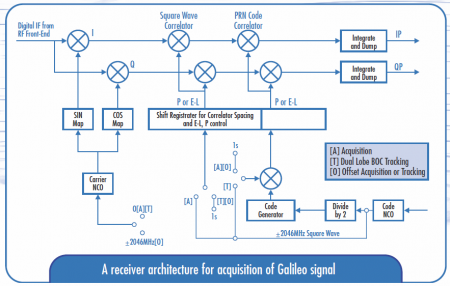If you wish to contribute or participate in the discussions about articles you are invited to contact the Editor
Galileo Receivers
| GALILEO | |
|---|---|
| Title | Galileo Receivers |
| Edited by | GMV |
| Level | Intermediate |
| Year of Publication | 2011 |
The Galileo System is an independent, global, European-controlled, satellite-based navigation system and provides a number of services to users equipped with Galileo-compatible receivers.
Basic elements of a generic GNSS Receiver are an antenna with pre-amplification, an L-band radio frequency section, a microprocessor, an intermediate-precision oscillator, a feeding source, some memory for data storage, and an interface with the user. The calculated position is referred to the antenna phase centre.
Galileo receivers
The Galileo global navigation satellite system employs many new methods and technologies to offer superior performance and reliability. Development of the advanced receivers required to make use of the system is continuing.[1]
A GALILEO Receiver is a device capable of determining a navigation solution by processing the signal broadcasted by Galileo satellites. Once the signal is acquired and tracked, the receiver application decodes the navigation message. The navigation data contain all the parameters that enable the user to perform positioning service. Data needed to perform positioning:[2]
- Ephemeris which are needed to compute the position of the satellite to the user receiver.
- Time and clock correction parameters which are needed to compute satellite clock offsets and time conversions.
- Service parameters with satellite health.
- The ionospheric parameters model, needed for single-frequency users.
- Almanac which allow less precise computation of the position of all the satellites in the constellation to facilitate the initial acquisition of the signals by the receiver.
For single frequency receivers, the Broadcast Group Delays are also needed.
Up-to-date ephemeris are needed to indicate the position of the satellite to the user receiver. Time and clock correction parameters for all the satellites are needed to compute pseudo-range. Receivers must retrieve the values of navigation parameters relevant to the type of navigation solution to be computed from the most recent navigation data set broadcast on a Healthy SIS by the Galileo system after the start of the current receiver operation. The navigation performance can be increased by implementing fault detection and isolation algorithms, as those based on the consistency of redundant pseudorange data sets (such as Receiver Autonomous Integrity Monitoring algorithms)[2].
Particularities
Each GNSS system uses a specific Reference Frame; although a multi-constellation receiver is able to convert all information to the same common frame, a Galileo-only receiver uses the Galileo GTRF reference frame. In an analogous way, each system has its own time reference defined by the respective control segments; the time reference for Galileo is called “Galileo System Time” (GST).
Each GNSS System transmits its own navigation message, defined in the respective Signal In Space Interface Control Documents, SIS ICD[3]. As an example, the satellites transmit information that allows the receiver to compute their positions. For the case of Galileo (in-line with GPS but unlike GLONASS), the satellites transmit the orbit parameters as updated by the Ground Segment and refreshed every 3 hours (in nominal operations). The Galileo receiver then computes the satellite position based on these transmitted ephemeris parameters.
Another distinction regarding the transmitted navigation message with impact on the receiver is the ionospheric parameters transmitted to support the single frequency receiver in computing the ionospheric error; Galileo uses the NeQuick Ionospheric Model.
GNSS signals modulation, structure, navigation message contents and formats are often different among signals from the same system and from different systems. Most of these characteristics are easily implemented at the receiver (e.g. requiring only “software modifications”, such as the use of different PRN codes or the ability to cope with different message structures). The main difference among GNSS receivers falls into the specific characteristics that have impact at RF level, such as the Multiple Access Techniques employed. Galileo (as GPS and BeiDou) uses CDMA techniques allowing a simpler RF module (than for example GLONASS), since all signals in the same frequency band have a common carrier.
It should be noted that the current trend consists on facilitating the access of each system to the receivers, i.e. fomenting multi-constellation receivers. Hence, most discussions and agreements among the systems’ responsible are conducted in the sense of taking this effort out of the user segment, focusing on compatibility and interoperability aspects in the system design.
Galileo receiver chain
Galileo sensor stations are equipped with high-performance, ultra-reliable receivers. The stations provide measurement data to the Galileo system central processing facilities for establishing system integrity and performing satellite orbit determination and time synchronisation.
Receivers
GNSS Receivers manufacturers have already made multi-constellation receivers designed for a variety of applications. These receivers support a wide range of satellite signals, including Galileo signals in E1 and E5 bands. Examples for devices that implement Galileo and user receiver technology trends can be found on the GSA website and in relevant GSA publications such as Market[4] and User Technology reports[5] respectively.
The Open Service Interface Control Document (ICD) for Galileo is available[3], so receiver manufacturers can already work to prepare the acquisition of real Galileo data.
Furthermore, the European GNSS Agency (GSA) has been supporting a number of activities within the user segment[6].

